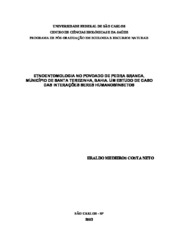| dc.contributor.author | Costa Neto, Eraldo Medeiros | |
| dc.date.accessioned | 2016-06-02T19:29:18Z | |
| dc.date.available | 2005-05-16 | |
| dc.date.available | 2016-06-02T19:29:18Z | |
| dc.date.issued | 2003-08-01 | |
| dc.identifier.citation | COSTA NETO, Eraldo Medeiros. Etnoentomologia no povoado de Pedra Branca, município de Santa Terezinha, Bahia. Um estudo de caso das interações seres humanos/insetos.. 2003. 253 f. Tese (Doutorado em Ciências Biológicas) - Universidade Federal de São Carlos, São Carlos, 2003. | por |
| dc.identifier.uri | https://repositorio.ufscar.br/handle/ufscar/1651 | |
| dc.description.abstract | The great diversity of insect species is perceived, classified, known, and used in different ways by many different human cultures. Considering the affective, cognitive and behavior aspects of the complex relationship that human beings maintain with these animals, an ethnoentomological research has been carried out with the dwellers of a small community from Bahia State countryside. Fieldwork was done from February to May 2001 in the village of Pedra Branca, which belongs to the town of Santa Terezinha. This town is located in the central-west region of the state. Data were obtained through open and semi-structured interviews, as well as by behavior observation by using the usual techniques of ethnographic recording. Most of the interviews were tape recorded. A total of 74 males and 79 females, whose ages ranged from 4 to 108 years old, were interviewed. Key-specialists were identified through the evidence of consolidated ethnoentomological knowledge. Results show the feelings, thoughts (knowledge and beliefs), and behaviors that intermediate the relationship between the dwellers of Pedra Branca and the local entomofauna. The following aspects were seen in the affective dimension: the perception and the emic construction of the ethnozoological dominion insect ; the negative impacts of the direct action of insects on human health; the ethnospecies considered as plagues; and the association of these animals to beneficial and/or harmful events. As for the cognitive dimension, the following aspects were observed: ethnoontogeny, biotransformation, and the natural history of those ethnospecies that were considered culturally important, such as wasps, bees, cicadas, ants, and spider wasps; an emphasis was given to the knowledge about ethnotaxonomy, distribution, phenology, ethology, abundance, seasonality, food ecology, and habitat. The behavioral dimension dealt with the usage of insects as medicines, food, toys, decorative pieces, and in rituals. It can be concluded that insects fulfill a significant meaning in the social-cultural life of the inhabitants of the Serra da Jibóia region. Their ethnoentomological knowledge manifests itself as a valuable resource that is sufficient to be taken into account in the developing process of the region, as well as in studies concerning the inventory of the local fauna. | eng |
| dc.format | application/pdf | por |
| dc.language | por | por |
| dc.publisher | Universidade Federal de São Carlos | por |
| dc.rights | Acesso Aberto | por |
| dc.subject | Entomologia | por |
| dc.subject | Etnoentomologia | por |
| dc.subject | Ethnoentomology | eng |
| dc.subject | Ethnotaxonomy | eng |
| dc.subject | Cognition | eng |
| dc.subject | Folk knowledge | eng |
| dc.title | Etnoentomologia no povoado de Pedra Branca, município de Santa Terezinha, Bahia. Um estudo de caso das interações seres humanos/insetos. | por |
| dc.type | Tese | por |
| dc.contributor.advisor1 | Pacheco, Josué Marques | |
| dc.description.resumo | A grande diversidade de espécies de insetos é percebida, classificada, conhecida e utilizada de diferentes maneiras por diferentes sociedades humanas. Considerando os aspectos afetivos, cognitivos e comportamentais da complexa relação dos seres humanos com os insetos, realizou-se uma investigação etnoentomológica junto a moradores de uma pequena comunidade do interior do estado da Bahia. O trabalho de campo foi feito de fevereiro a maio de 2001 no povoado de Pedra Branca, o qual pertence ao município de Santa Terezinha situado na região centro-oeste do estado. Os dados foram obtidos através de entrevistas abertas e semi-estruturadas e por meio de observações comportamentais, recorrendo-se às técnicas usuais de registro etnográfico. A maior parte das entrevistas foi registrada em fitas micro-cassetes. Foram contatados 74 homens e 79 mulheres, cujas idades variaram de 4 a 108 anos. Especialistas-chave foram identificados a partir da constatação da posse de um saber etnoentomológico consolidado. Os resultados evidenciam os sentimentos, pensamentos (conhecimentos e crenças) e comportamentos que intermediam as relações dos moradores de Pedra Branca com a entomofauna local. Na dimensão afetiva, foram registrados os seguintes aspectos: a percepção e a construção êmica do domínio etnozoológico inseto ; os impactos negativos da ação direta dos insetos sobre a saúde humana; as etnoespécies tidas como daninhas às plantações locais; e a associação desses animais a acontecimentos benéficos e/ou maléficos. Quanto à dimensão cognitiva, os seguintes aspectos foram observados: etnoontogenia, biotransformação e a história natural de etnoespécies consideradas culturalmente importantes, tais como marimbondos, abelhas, cigarras, formigas e cavalos-do-cão; deu-se ênfase ao conhecimento sobre etnotaxonomia distribuição, fenologia, etologia, abundância, sazonalidade, ecologia trófica e hábitat. A dimensão comportamental tratou dos usos medicinal, alimentar, lúdico, estético-decorativo, ritualístico, entre outros. Conclui-se, então, que os insetos desempenham um papel significativo na vida sócio-cultural dos moradores da região da Serra da Jibóia. Por outro lado, o conhecimento etnoentomológico traduz-se em um recurso valioso que deve ser considerado no processo de desenvolvimento da região e em estudos de inventário da fauna local. | por |
| dc.publisher.country | BR | por |
| dc.publisher.initials | UFSCar | por |
| dc.publisher.program | Programa de Pós-Graduação em Ecologia e Recursos Naturais - PPGERN | por |
| dc.subject.cnpq | CIENCIAS BIOLOGICAS::ZOOLOGIA | por |
| dc.contributor.authorlattes | http://genos.cnpq.br:12010/dwlattes/owa/prc_imp_cv_int?f_cod=K4790802D8 | por |
